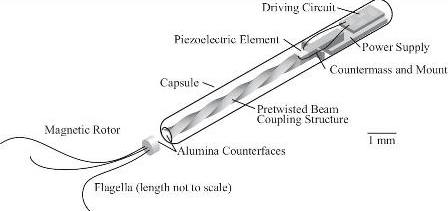Micromotors small enough to swim in human arteries
25 January 2009
Researchers at Monash University in Australia have developed a micro motor small enough to be injected into human arteries. It could be used for the safer treatment of stroke victims, hardened arteries or blockages in the bloodstream.
The researchers from the Micro/Nanophysics Research Laboratory at Australia’s Monash University have published details of their device in the Journal of Micromechanics and Microengineering [1].
The 'microbot', which is just a quarter of a millimetre, wide is powered by piezoelectricity, the energy most commonly used to trigger-start a gas stove.
The piezoelectric element vibrates at ultrasonic frequency. This is turned into rotational movement through clever coupling to a helical stator, which has so far achieved speeds up to 1295 rpm. The researchers are now considering adding an E. coli-like flagellum as a means of propulsion through the bloodstream.
Methods of minimally invasive surgery, such as keyhole surgery and a range of operations that utilise catheters, tubes inserted into body cavities to allow surgical manoeuvrability, are preferred by surgeons and patients because of the damage avoided when contrasted against cut and sew operations.
Serious damage during minimally invasive surgery is, however, not always avoidable and surgeons are often limited by, for example, the width of a catheter tube which, in serious cases, can fatally puncture narrow arteries.
Remote-controlled miniature robots small enough to swim up arteries could save lives by reaching parts of the body, lsuch as a stroke-damaged cranial artery, that catheters have previously been unable to reach (because of the labyrinthine structure of the brain that catheters are too immobile to safely reach).
With the right sensor equipment attached to the microbot motor, the surgeon’s view of, for example, a patient’s troubled artery can be enhanced and the ability to work remotely also increases the surgeon’s dexterity.
As Professor James Friend, leader of the research team at Monash University, explained, motors have lagged behind in the age of technological miniaturisation and provide the key to making robots small enough for injection into the bloodstream. “If you pick up an electronics catalogue, you’ll find all sorts of sensors, LEDs, memory chips, etc that represent the latest in technology and miniaturisation. Take a look however at the motors and there are few changes from the motors available in the 1950s,” he said.
Professor Friend and his team began their research over two years ago in the belief that piezoelectricity was the most suitable energy force for micro-motors because the engines can be scaled down while remaining forceful enough, even at the sizes necessary to enter the bloodstream, for motors to swim against the blood’s current and reach spots difficult to operate upon.

The structure of the microbot
Piezoelectricity is most commonly found in quartz watches and gas stoves. It is based on the ability of some materials to generate electric potential in response to mechanical stress. In the case of a gas stove, the ignition switch on a stove triggers a spring to release a ball that smashes against a piece of piezoelectric material, often kinds of crystal, which translates the force of the ball into more than 10,000 volts of electricity which then travels down wires, reaches the gas, and starts the stove fire.
As Professor Friend explains, “Opportunities for micro-motors abound in fields as diverse as biomedicine, electronics, aeronautics and the automotive industry. Responses to this need have been just as diverse, with designs developed using electromagnetic, electrostatic, thermal and osmotic driving forces. Piezoelectric designs however have favourable scaling characteristics and, in general, are simple designs, which have provided an excellent platform for the development of micro-motors.”
The team has produced prototypes of the motors and is now working on ways to improve the assembly method and the mechanical device which moves and controls the micro-motors.
Reference
1. B Watson, J Friend and L Yeo. Piezoelectric ultrasonic resonant motor with stator diameter less than 250 μm: the Proteus motor. J. Micromech. Microeng. 19 (2009) 022001 (5pp).
Bookmark this page